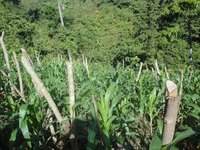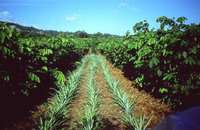Shifting agriculture is traditionally practiced by many subsistence farming families in the tropics. Farmers cut and burn patches of rainforest to improve soil fertility and grow food. This soil fertility improvement is temporary, and cycles of soil degradation and diminishing crop yields force farming families to clear new patches of rainforest to survive. Central American areas under shifting cultivation have not declined in the last 20 years (Heinimann et al., 2017). Practices like Inga agroforestry will help to reverse this trend.
.png?w=600)
Figure 3. Before (left) and after (right) Inga alley cropping has been implemented on one farm. Source: Inga Foundation
This agroforestry system uses Inga spp., nitrogen-fixing trees, to regenerate the steepest and most degraded land. This system sequesters and avoids emitting tons of carbon while transforming the lives of subsistence farming families. The project, now in year thirteen, is working at the landscape-scale in northern Honduras (Figure 3), in the river catchments of the Cuero and Cangrejal that form the Western and Eastern boundaries of the Pico Bonito National Park.
History
Inga Foundation’s Founder/Director, tropical ecologist Mike Hands, determined that declining yields with slash and burn agriculture are linked to its adverse effects on phosphorous nutrition (Hands et al., 1995). 3
Of the different potential alternatives investigated by Hands (2021), the only sustainable system emerging from years of scientific research was alley cropping using nitrogen-fixing tree species from the genus Inga. Inga alley cropping maintains soil fertility and good harvests year after year, breaking the cycle of burning and allowing families to achieve long-term food security on one piece of land.
Process
In the Inga Foundation systems, Inga tree seedlings (Inga edulis and Inga oerstediana) are planted. Both are hardy with a 95% survival rate. Inga seeds do not store well, so they are planted soon after removal from their seed pods. The Foundation supplies the seeds and bags to families desiring to start their own. Seedlings grow for at least a month in the nursery to 15 cm tall before they are ready for transplanting from grow bags. Trees are spaced 50 cm apart in rows or along contours when planted on steep slopes, at 4 m between alleys/rows, for a planting density of 4000 to 5000 trees per ha. Trials showed seedlings have better survival rates by allowing their strong taproots to establish, rather than attempting to root stem cuttings.
Inga has few pests except for leafcutter ants (Atta spp. and Acromyrmex spp.), controlled by natural predators in the ecosystem. For early crop development, a small side-dressing of 50 kg per ha of rock phosphate/lime/sulfate of potash magnesia is applied every five years. Inga grows quickly and after 20 to 24 months, trees are pruned (pollarded), to about 1.5 m. Smaller prunings and stripped leaves are mulched in the cropping area. After the Inga prunings decompose, they provide additional nitrogen, and cycle other nutrients required by the crop. The prunings establish a thick layer of mulch that protects the soil surface from erosive forces and reduces evaporation. Larger branches are used as firewood, providing families with fuelwood for cooking and addressing deforestation. Unpruned trees produce seeds, and most families plant several Inga for their own seed source. After harvesting the annual crops, the cycle repeats.
The average subsistence family holding in northern Honduras is estimated to be 8 ha (Munguia, 1995) but many families have half of this area available, as much of their land is steep, rock-strewn slopes. These are not suitable for cultivation and would be burned annually. The value of this sustainable alternative is that land is transitioned from unsustainable cycles of burning to sustainable, permanent agroforestry land uses.
Inga Land Use Systems

Figure 4. Maize intercropped with already-pruned Inga. Source: Inga Foundation
Land uses with Inga are adaptable, according to household needs and availability. Four options of the Inga agroforestry that farmers may choose are:
- Inga alley cropping for food security in basic grains primarily corn and beans (Figure 4). Inga alley cropping for appropriate cash crops which are grown between alleys: (e.g., pepper [Piper nigrum]) and turmeric [Curcuma longa] among others).
- Fruit trees with Inga in orchard configuration (400 trees per ha) provide shade and naturally fixed nitrogen. They are also companion trees for a range of fruit crops; (e.g., cacao [Theobroma cacao], avocado [Persea americana], rambutan [Nephelium lappaceum)], and citrus [Citrus spp.)];).
- Reforestation with Inga used as ‘matrix’ or ‘framework’ species for reclamation; to be interplanted 6 to12 months later with valuable tropical hardwoods.
Another value of Inga alley cropping for food security is that it enables the other model components to be established (Figure 5).
.png?w=1200)
Figure 5. Example of cycling through different Inga alley cropping models. Source: Inga Foundation
Families work together to implement the system by providing the land, labor, and care without incurring debt or requiring loans. A local Honduran team aids in training farmers for the first pruning. After that, each family chooses the crop/fruit tree/hardwood agroforestry system best suited for them.
Benefits of Inga alley cropping
- Fulfills 12 of the United Nations Sustainable Development Goals.
- Smallholder families (500+) can work closer to home and have organically grown, sustainable food and firewood with annual tree pruning. Family farms grow and sell cash crops, improving livelihoods and food security.
- Improved family nutrition reduces migration to cities and foreign countries. Local economies improve when youth have the opportunity to farm for both food and income, with women and girls’ fully participating.
- Rainforest/wildlife habitats protected-4680 ha of land prevented from burning; 3000 ha of agroforestry within regenerated landscapes/biological corridors. Rainforests are not cut for planting or firewood and over 2 million trees have been planted.
- Carbon sequestered and carbon emissions avoided-846,000 tons of C since 2012; No unintended and escaped fires.
- Nitrogen-fixing trees enrich soils, regenerating degraded land in 20-24 months. Soils (steep slopes) are stabilized by Inga and enriched by leaf mulch. Water sources are protected, and erosion and mudslide control protects coral reefs and ocean wildlife.
- No chemical fertilizers, GMOs, heavy equipment, pesticides, or herbicides are needed.
Now, in the thirteenth year of this program, families who planted crops with the Inga alley cropping have had food when their neighbors who used traditional burning experienced crop failure. Inga trees have survived the worst effects of heat, drought, and rains. In 2019, Honduras declared a state of emergency in the southern regions of the country reporting losses of 72% of corn and 75% of beans.4 Yet, families with Inga tree alleys had reduced but sufficient yields so that even in the worst growing conditions, families still produced enough food for them to sustain themselves.
While our Honduran local team provides one-on-one support during the 20-month planting and pruning cycle, the families pay it forward, planting seedlings to help their neighbors establish their own alleys. Each year, 30 to 40 new families are trained. Families prune the alleys they established during the previous year, easily learning the practice. Not one family has gone back to clearing/burning and adoption is widespread (there are two hundred families waiting to plant their basic grain alley as of publication). Food security is the overarching goal for families. 5
Next steps
Inga alley-cropping creates an integrated ecosystem that resembles natural conditions on the forest floor. This conserves soil moisture and replenishes the soil while also preventing erosion and mudslides, thereby protecting wildlife and marine habitats. Allowing families to stay on one plot of land stops the socially destructive rural-urban migration that results from slash-and-burn’s failure to sustain subsistence agriculture.

Figure 6. Inga and pineapple intercrop. Source: Inga Foundation
We can expand the program at our demonstration farm at Las Flores (Atlántida), with its seed bank, arboretum, training center, and large nursery capacity. Cash crops from our nursery are distributed to adopting smallholders who choose from (turmeric, cacao, citrus, avocado, black pepper, rambutan, pineapple (Ananas comosus; Figure 6), allspice (Pimenta dioica), vanilla (Vanilla planifolia), and passion fruit, (Passiflora edulis). Families who have already been trained are growing 400,000 cacao and nearly 100,000 black pepper. Our experienced Honduran team has taught and facilitated native alley cropping in 15 countries. Using the plots and experiences of families eager to take part, our own demonstration and teaching facilities serve as models of sustainable best practices for rural livelihoods. Protecting the larger environment, avoiding future habitat destruction, and re-creating forest and agroforest cover is a successful, simple solution to many serious global problems.
Videos
- 3-minute Vimeo- Inga Foundation [http://edn.link/2rqy79]
- Transforming Lives & Landscapes-The Inga Tree Model [http://edn.link/2mpgcp]
- Mike Hands presentation on Inga Alley Cropping at Knowledge Partners Program [http://edn.link/n7prac]
- How to set up Inga in alleys and prune [http://edn.link/tzjj9x]
- Nine Reasons Why Inga is an Essential Part of Successful Alley Cropping [http://edn.link/2h477q]
For further reading:
Hands, M. and L. Potter, L. Torquebiau E (ed.). 2024. Agroforestry at work. Tropical Forest Issues 62. Tropenbos International, Ede, the Netherlands (pp. 52–58). The Spanish and French versions of the publication “Agroforestry at work”, including the 25 individual articles, can be downloaded from their website. [http://edn.link/teexqc]
References
Hands M. 2021. The search for a sustainable alternative to slash-and burn agriculture in the World’s rainforests: the Guama Model and its Implementation. Royal Society Open Science 8(2): 201204. https://doi.org/10.1098/rsos.201204.
Hands, M.R., A.F. Harrison, and T. Bayliss-Smith. 1995. Phosphorus Dynamics in Slash-and-burn- and Alley Cropping systems of the humid tropics. In: Phosphorus in the Global Environment. John Wiley & Sons Ltd.
Heinimann,A.,Mertz,O, Frolking, S., Christensen, A., Hurni, K., Sedano, F., Chini, L., Sahajpal, R., Hansen, M., Hurtt, G. 2017. A global view of shifting cultivation: Recent, current, and future extent. Plos One. 12(9). https://doi.org/10.1371/journal.pone.0184479
Munguia, M.O. 1995. personal communication.
Radwin, M. 2021. Inga tree points to way out of slash-and-burn for Central American Farmers. In; Mongabay: News and Inspiration from Nature’s Frontline.